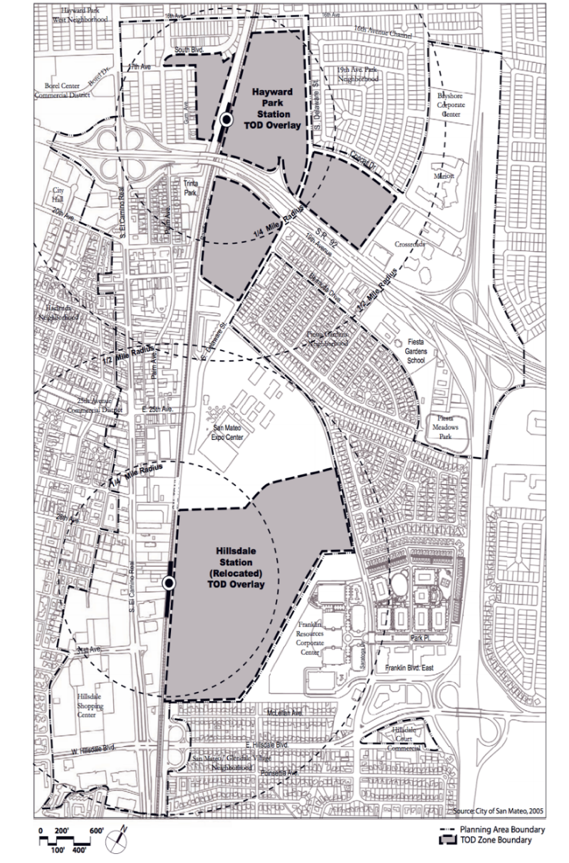
Transportation Demand Management
Case Study – City of San Mateo: Trip Reduction in Transit Neighborhoods
Place-type: Transit Town Center, Mixed-Use Corridor
Overview

Adopted in 2005, the City of San Mateo’s Rail Corridor Transit Oriented Development Plan guides the development of an array of land use and transportation projects around two Caltrain commuter rail stations – Hillsdale and Hayward Park. Transportation Demand Management (TDM) measures are integrated into the Rail Corridor Plan for residents and employers to support a 25% motor vehicle trip reduction, even as new development is occurring. To achieve this target, the City of San Mateo Rail Corridor includes TDM measures such as:
- Parking cash-out programs that give employees a cash payment if they forgo a free parking space
- Market-rate residential parking charges/prices
- Transit pass subsidy for employees or residents
- On-site car-share programs (e.g. Zipcar)
- Residential permit parking (allows residents to park on the streets in their neighborhood)
- Preferential high occupancy vehicle (HOV – e.g., vanpool vehicles) parking and carpool promotion and coordination
- Bicycle parking and commuter facilities (including locker rooms and showers)
The above measures reduce the need for excess car parking, which reduce housing development costs and the impact of new development on traffic congestion.
Policies/Ordinances that Contributed to Project Success
- The TDM plan has a built-in accountability mechanism to monitor transportation outcomes in new developments. Trip reduction will be measured against available trip generation for traditional projects that do not benefit from the TOD
- The City of San Mateo’s Below Market Rate (BMR) Inclusionary Program requires developers of new housing to provide a percentage of the affordable units to very low, low, or moderate-income residents for projects of 11 or more units.
- The Connect San Mateo program, a partnership with Commute.org and SamTrans, offers residents and commuters an interactive and user-friendly website to explore the alternative transportation options available within the City of San Mateo.
- The City’s zoning code allows for more intense development, with a maximum building height of 55′. That height can be 75′ in designated areas if a public benefit is involved, such as transit supportive policies, mixed land uses, and higher development densities.
Outcomes
The City of San Mateo TDM strategies are in the early stages of implementation. From 2016 to 2017 within the Rail Corridor Plan area, motor vehicle volumes fell by 2%, and pedestrian and bicycle trip volumes increased by 37% and 47%, respectively.
Challenges and Lessons Learned
- Although the zoning code is flexible and includes development incentives, the small size of parcels and overall height limits may act as disincentives for parties interested in private redevelopment.
- Employer TDM strategies tend to be the most effective means of reducing peak period automobile trips and promoting transit usage. Trip reduction is more difficult for residential projects because residents may want to own a car even if they do not drive to work every day.
- The TDM plan identified early on that these requirements needed accountability to be truly successful, leading to the establishment of a process by which projects/developments are responsible for their trip reduction efficacy. The annual monitoring process requires developers or project owners to report annually on how/if the project is meeting the vehicle trips reduction targets.